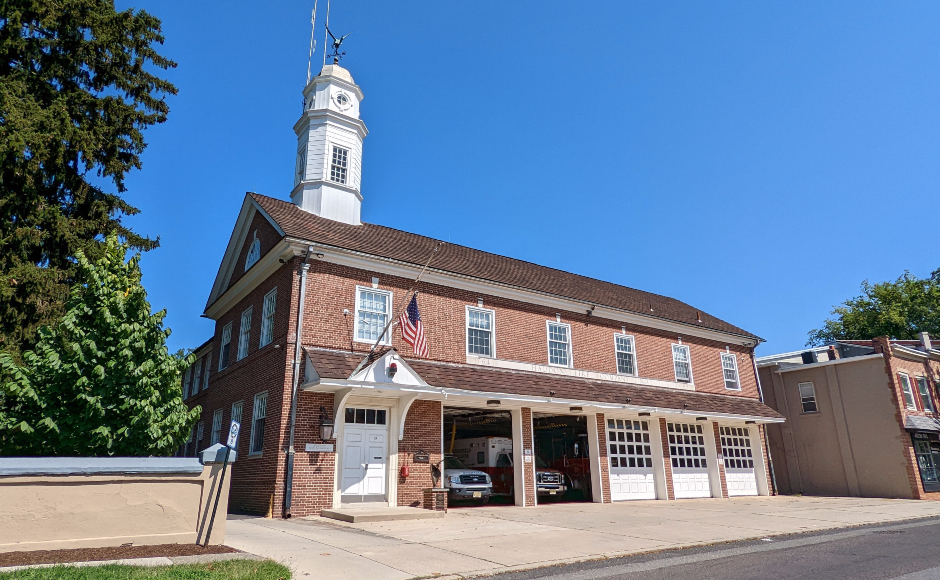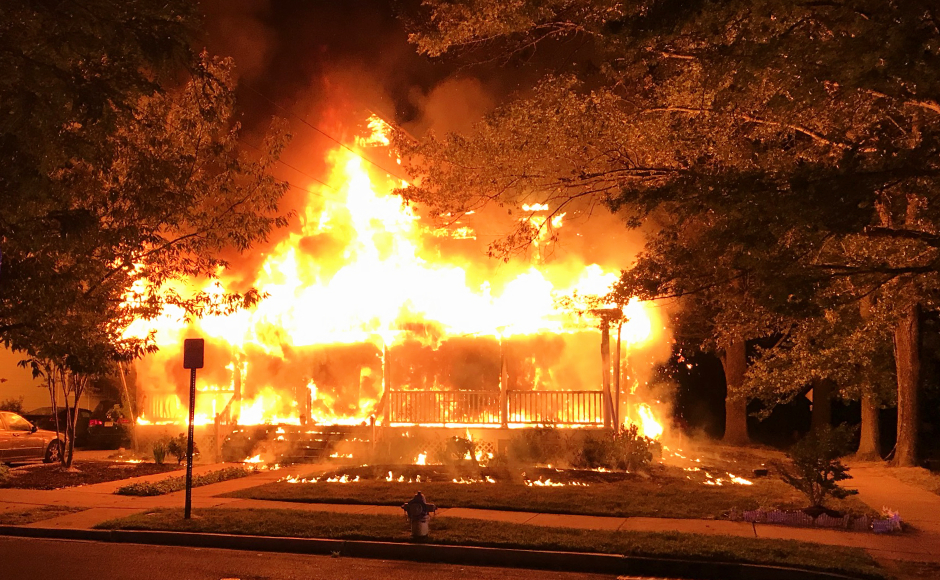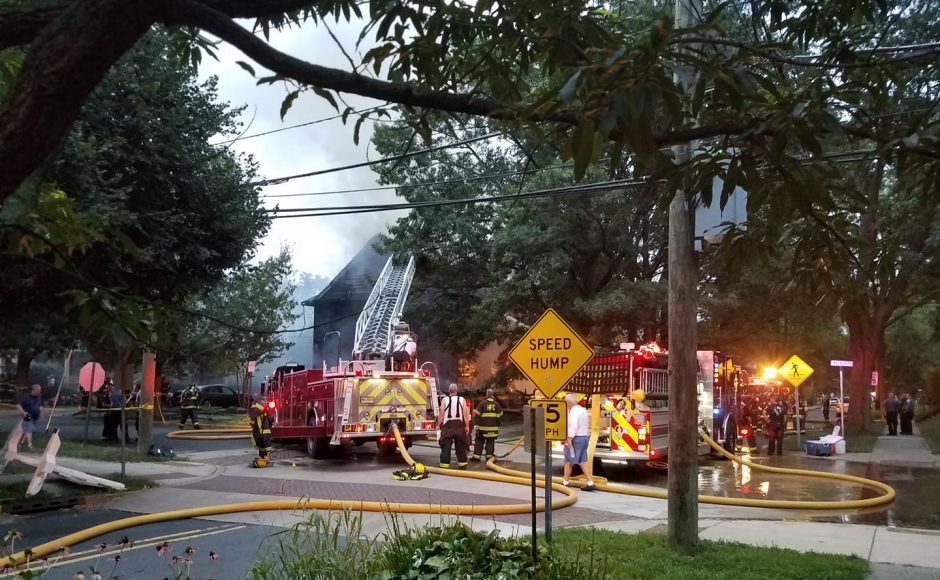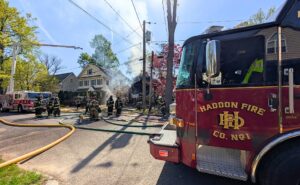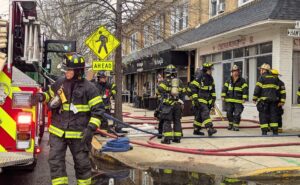Haddon Fire Company No. 1, one of the oldest continuously operating volunteer fire companies in America, is walking a tightrope between preserving its history and adequately staffing its services at a time when volunteer firefighters are hard to come by.
By Matt Skoufalos | September 16, 2022
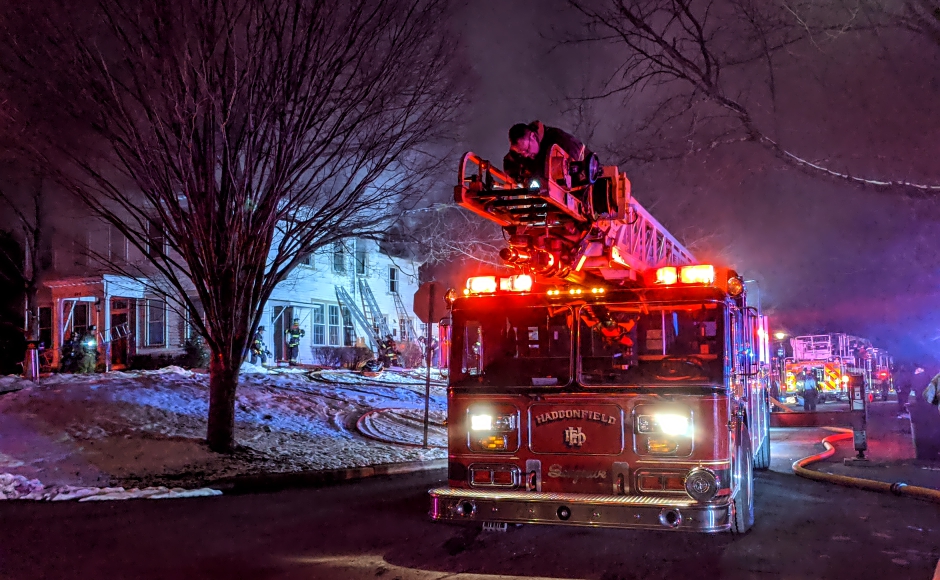
Firefighters respond to a call at a historic Haddonfield home Feb. 12, 2021. Credit: Matt Skoufalos.
In July, the Haddonfield borough government entered into an agreement to study whether a shared services agreement with neighboring Haddon Heights and Barrington would help address staffing concerns at volunteer fire departments in all three communities.
The “Tri-Borough Emergency Services Study and Implementation Plan” will explore ways to deliver round-the-clock fire protection to all three towns without overwhelming their budgets.
Whatever the outcome of that study, Haddonfield is moving ahead with a trial program designed as a stopgap to staffing concerns at its fire department.
Borough commissioners have committed $130,000 in surplus funds to the project, which will used to establish three-and-four-person overnight duty crews at Haddon Fire Company No. 1.
Each volunteer working the overnight hours of 7 p.m. to 7 a.m. will be entitled to a stipend of $150 per shift. The program will run from September 24 through January 31, 2023, during which time the borough government and fire officials will collect and analyze performance data at the firehouse.
Haddonfield Fire Chief Lou Frontino hopes the program, however temporary, will entice more volunteers to join the department. Currently, only 19 of its 41 members reside within the borough itself. The remainder hail from neighboring communities, like Cherry Hill.
“It’s on my fire department and myself to have it staffed, and get it operating, and make sure it’s going to serve the community’s purpose,” Frontino said.
For the oldest continuously operating volunteer fire company in the nation, maintaining operations without paid personnel is more than a footnote in its legacy, it’s a point of immense pride. The stipends won’t overturn its volunteer status, but they will hopefully provide enough of a hook to help more members provide much-needed local fire coverage.
“For the most part, you don’t see a volunteer committing 12 hours every week, or every day, because they come when they can,” Frontino said. “This is something to incentivize them so they have to be at the firehouse.”
The distinction between volunteer and career firefighters may seem negligible to an outsider.
Paid or not, firefighters must complete 200 hours of training to begin working the job, and are subject to the same liability in performing it.
But with few career fire departments in the area, even prospective professional firefighters need volunteer opportunities to build their resumes.
“In my firehouse, they’re all looking for career jobs, but I also have a sizable membership that’s professionals,” Frontino said. “Insurance is the same; municipalities have to have them covered. Worker’s comp’s the same. They get the same care.”
Whatever its personnel composition, Haddon Fire Company is working to bring down its call response times; having local full-time crews on hand would do that.
The national standard response time — measured from the time dispatchers call the station to the time the company is fully staffed and en route to the call — is two minutes. Haddonfield presently averages a five-to-seven-minute response, Frontino said.
Part of the lag involves the distance out-of-town volunteers must travel to reach the station.
“Our main goal is to protect the community, and get those response times lowered to national standards,” the chief said. “We have Cherry Hill volunteers who are coming at a distance, so even when it’s 1 in the morning, it takes some time to get there.”
Haddonfield Mayor Colleen Bianco Bezich said the stipend program represents a good first step towards resolving long-term sustainability issues the borough fire service is confronting. Officials had hoped the stipend program would help recruit daytime crews, but too few volunteers were available. Overnight hours don’t feature as high of a call volume, but volunteers who work a day job are likelier to be available to respond then.
“The initial request was 24/7 coverage,” Bianco Bezich said. “At $150 per firefighter per shift for three- or four-person crews, we were looking at $500,000, easy.
“Then we sat down and had the real conversations — Do we even have enough firefighters to cover these crews during the day to staff these shifts? — and the answer was no.”
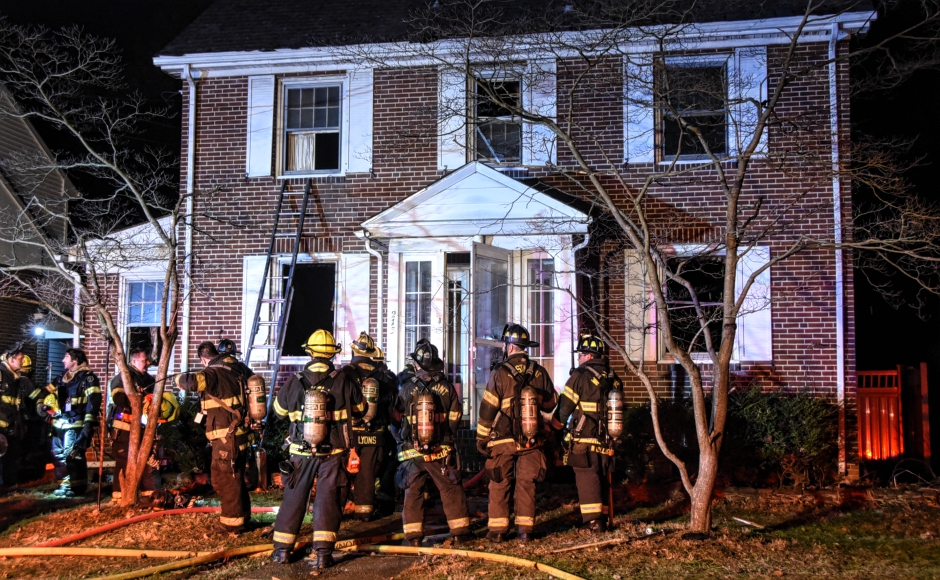
Firefighters contain a house fire on Ardmore Avenue in Haddonfield Jan. 16, 2020. Credit: Curt Hudson.
Bianco Bezich said the pilot program took a year of conversations among herself, Frontino, and Haddon Fire Company President Karl Foote, to develop.
Borough administrator Sharon McCullough sourced surplus funds to cover the cost of the program while the shared services study is being developed.
Even if the program is successful, however, longer-term challenges involving the nature and structure of the department will persist.
One of the fundamental concerns that cannot be worked around is the length of time required to train a new firefighter. To complete the 200-hour basic training and get a new firefighter on the active duty roster can take nine to 12 months.
Bianco Bezich said the group also considered creating a temporary, part-time department until the results of the tri-town study are known, but officials concluded that “that would kill morale,” she said.
“This fire company is 200 years old, and this is the first time we’re paying people,” Bianco Bezich said. “Individuals who wanted to take those part-time, paid shifts would then not be able to volunteer to work unpaid because of labor laws.
“When I explained that to the younger members, I think it was the first time they heard that,” the mayor said. “I think it was shocking and disappointing for them.”
The federal Fair Labor Standards Act (FLSA) sets strict limitations on even part-time, stipend payments for firefighters. According to “Managing Volunteer Firefighters for FLSA Compliance: A Guide for Fire Chiefs and Community Leaders,” firefighters can receive monthly or annual stipends, but these can’t total more than 20 percent of a full-time firefighter’s wages.
Without a paid company in Haddonfield, those wage comparables are established on the local average of what firefighters in nearby towns are paid. Even assuming an average annual firefighter salary of $50,000, each individual firefighter would exhaust that 20 percent earnings threshold ($10,000) after 67 shifts of work.
Neither does that solve the revenue problem of how to cover the costs of the department going forward, which include fire apparatus, equipment, pensions and insurance, to say nothing of wage costs. Even with the borough ambulance services potentially contributing a couple hundred thousand dollars annually, there’s still a funding shortfall.
All parties involved acknowledge that the stipend program is an intermediary step in the longer-term process of solving the question of fire protection in Haddonfield.
The bigger challenge is preserving a 19th-century organization for 21st-century operations.
“What we’re faced with is members committed to history, who don’t want to be paid because that’s the end of the volunteer department,” Bianco Bezich said.
“We can still celebrate the history, but we can’t pretend that clinging to this volunteer status is the only way.
“We’re incredibly grateful for the volunteers we have,” she said. “We have volunteers of all ages who are doing their best to keep Haddon Fire Co. alive. They’re saving lives, and they deserve to be thanked for that. But we have to be honest about the challenges we’re facing.”
From Frontino’s perspective, whether the stipend program is a path to a regional fire service or some form of partially paid department, the financial costs of firefighting aren’t budging, and somehow, they must be addressed.
“I don’t think the county or the municipalities have the money to staff firehouses with career firefighters at this point,” he said. “It’s a real expense. We have apparatus to maintain. You have equipment, gear; it’s a very expensive department.
“Then you have our EMS staff, which salary and wages on that is really high,” Frontino said. “It’s really taxing for a small borough like Haddonfield, Barrington, Haddon Heights. Even Cherry Hill: they have a huge fire budget, but that doesn’t cover everything.
“My only hope is this study comes out and tells our towns how we can work together, what the deficits are, and come to an agreement that works,” the chief said.

